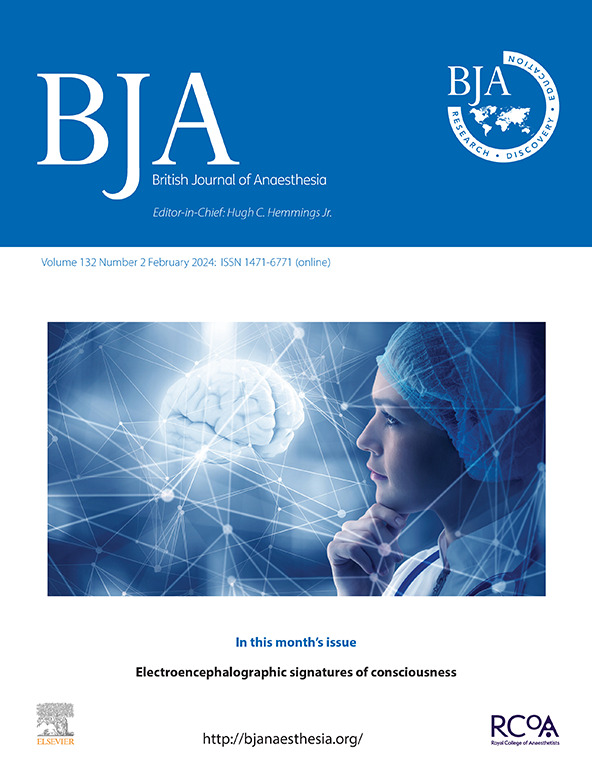Factors associated with a reduction in the preventive effect of intravenous dexamethasone on rebound pain after axillary brachial plexus block.
IF 9.1
1区 医学
Q1 ANESTHESIOLOGY
引用次数: 0
Abstract
BACKGROUND Rebound pain after regional anaesthesia remains a significant clinical problem. Intravenous dexamethasone is commonly used as an adjuvant to prevent rebound pain although its effectiveness varies among patients. We aimed to identify phenotypic and biological factors influencing glucocorticoid sensitivity contributing to dexamethasone resistance in the prevention of rebound pain. METHODS Patients undergoing ambulatory upper limb surgery with an axillary brachial plexus block were enrolled prospectively to receive dexamethasone (0.1 mg kg-1 i.v.) before surgery. Preoperative factors analysed encompassed clinical aspects (central sensitivity, anxiety, and pain scores) and biological parameters (salivary cortisol, annexin-A1, and blood inflammatory markers). Postoperative outcomes comprised rebound pain incidence (numerical rating scale >7 within the first 24 h) and persistent pain at 3 months. RESULTS Of the 104 patients included, 36 (34.6%) developed rebound pain. Preoperative nocturnal awakening pain (odds ratio [OR]=3.09, P=0.03), severe anxiety (OR=3.54, P=0.01), high catastrophising score (OR=4.14, P=0.01), and low salivary cortisol levels (<1147 pg ml-1) (OR=3.33, P=0.02) were associated with an increased risk of rebound pain. Persistent pain at 3 months (27%) was associated with the presence of postoperative rebound pain (P=0.04). CONCLUSIONS Preoperative nocturnal pain, severe anxiety, high catastrophising, and low salivary cortisol levels are factors that might reduce the efficacy of dexamethasone in preventing rebound pain. These findings support the development of personalised preventive strategies. CLINICAL TRIAL REGISTRATION NCT05763433.静脉注射地塞米松对腋窝臂丛阻滞后反跳性疼痛预防作用降低的相关因素。
背景:局部麻醉后的束缚性疼痛仍然是一个重要的临床问题。静脉注射地塞米松通常被用作预防反跳性疼痛的辅助剂,尽管其有效性因患者而异。我们的目的是确定影响糖皮质激素敏感性的表型和生物学因素,这些因素有助于地塞米松抵抗预防反跳疼痛。方法前瞻性选择行上肢门诊手术合并腋窝臂丛阻滞的患者,术前给予地塞米松(0.1 mg kg-1静脉注射)。术前因素分析包括临床方面(中枢敏感性、焦虑和疼痛评分)和生物学参数(唾液皮质醇、膜联蛋白a1和血液炎症标志物)。术后结果包括前24小时内反跳性疼痛发生率(数值评定量表bbb70)和3个月时的持续性疼痛。结果104例患者中,36例(34.6%)出现反跳性疼痛。术前夜间觉醒疼痛(比值比[OR]=3.09, P=0.03)、重度焦虑(OR=3.54, P=0.01)、高灾难化评分(OR=4.14, P=0.01)、低唾液皮质醇水平(<1147 pg ml-1) (OR=3.33, P=0.02)与反跳性疼痛风险增加相关。3个月时持续疼痛(27%)与术后反跳疼痛相关(P=0.04)。结论术后夜间疼痛、严重焦虑、高致畸性和低唾液皮质醇水平可能是降低地塞米松预防反跳性疼痛疗效的因素。这些发现支持个性化预防策略的发展。临床试验注册号nct05763433。
本文章由计算机程序翻译,如有差异,请以英文原文为准。
求助全文
约1分钟内获得全文
求助全文
来源期刊
CiteScore
13.50
自引率
7.10%
发文量
488
审稿时长
27 days
期刊介绍:
The British Journal of Anaesthesia (BJA) is a prestigious publication that covers a wide range of topics in anaesthesia, critical care medicine, pain medicine, and perioperative medicine. It aims to disseminate high-impact original research, spanning fundamental, translational, and clinical sciences, as well as clinical practice, technology, education, and training. Additionally, the journal features review articles, notable case reports, correspondence, and special articles that appeal to a broader audience.
The BJA is proudly associated with The Royal College of Anaesthetists, The College of Anaesthesiologists of Ireland, and The Hong Kong College of Anaesthesiologists. This partnership provides members of these esteemed institutions with access to not only the BJA but also its sister publication, BJA Education. It is essential to note that both journals maintain their editorial independence.
Overall, the BJA offers a diverse and comprehensive platform for anaesthetists, critical care physicians, pain specialists, and perioperative medicine practitioners to contribute and stay updated with the latest advancements in their respective fields.

 求助内容:
求助内容: 应助结果提醒方式:
应助结果提醒方式:


